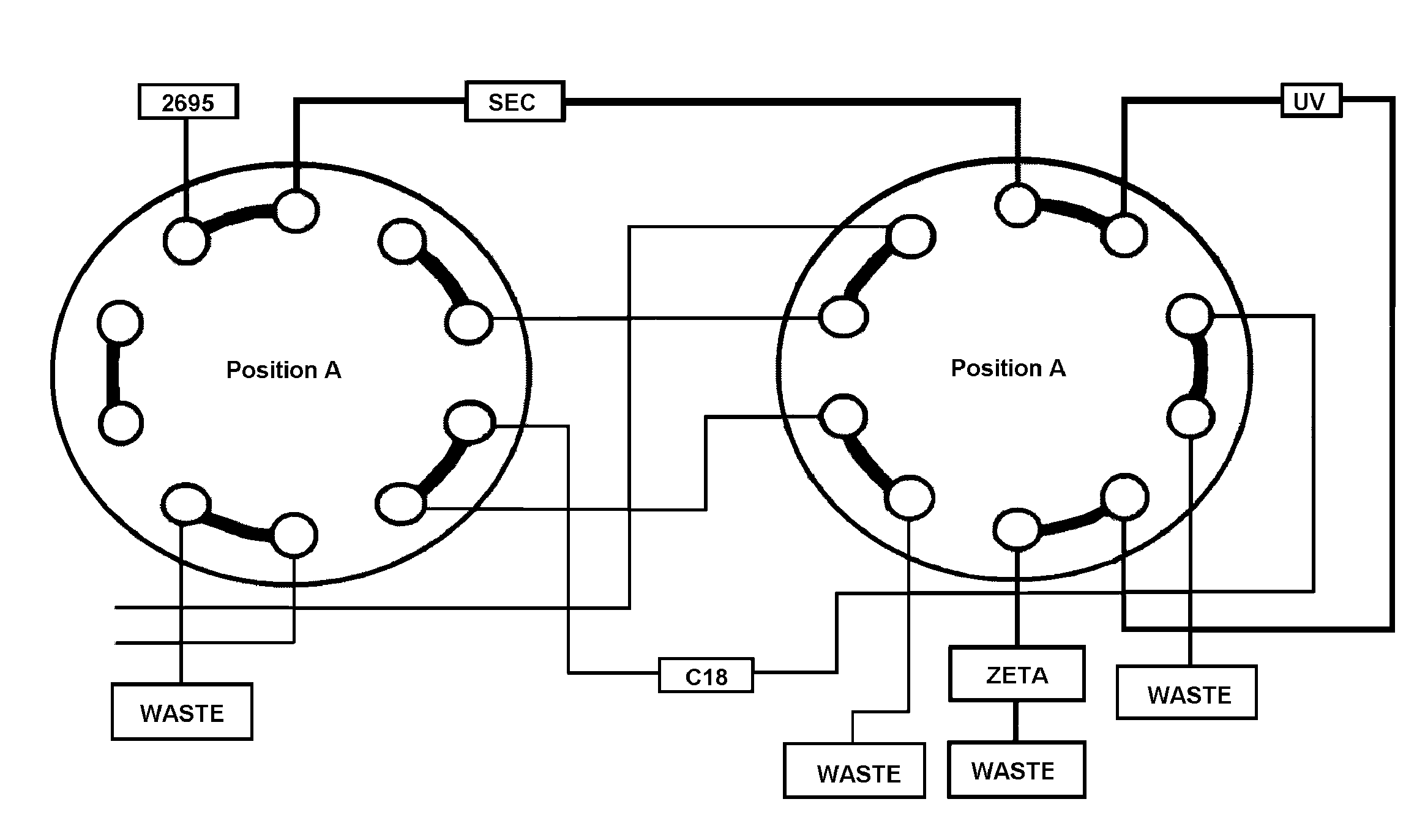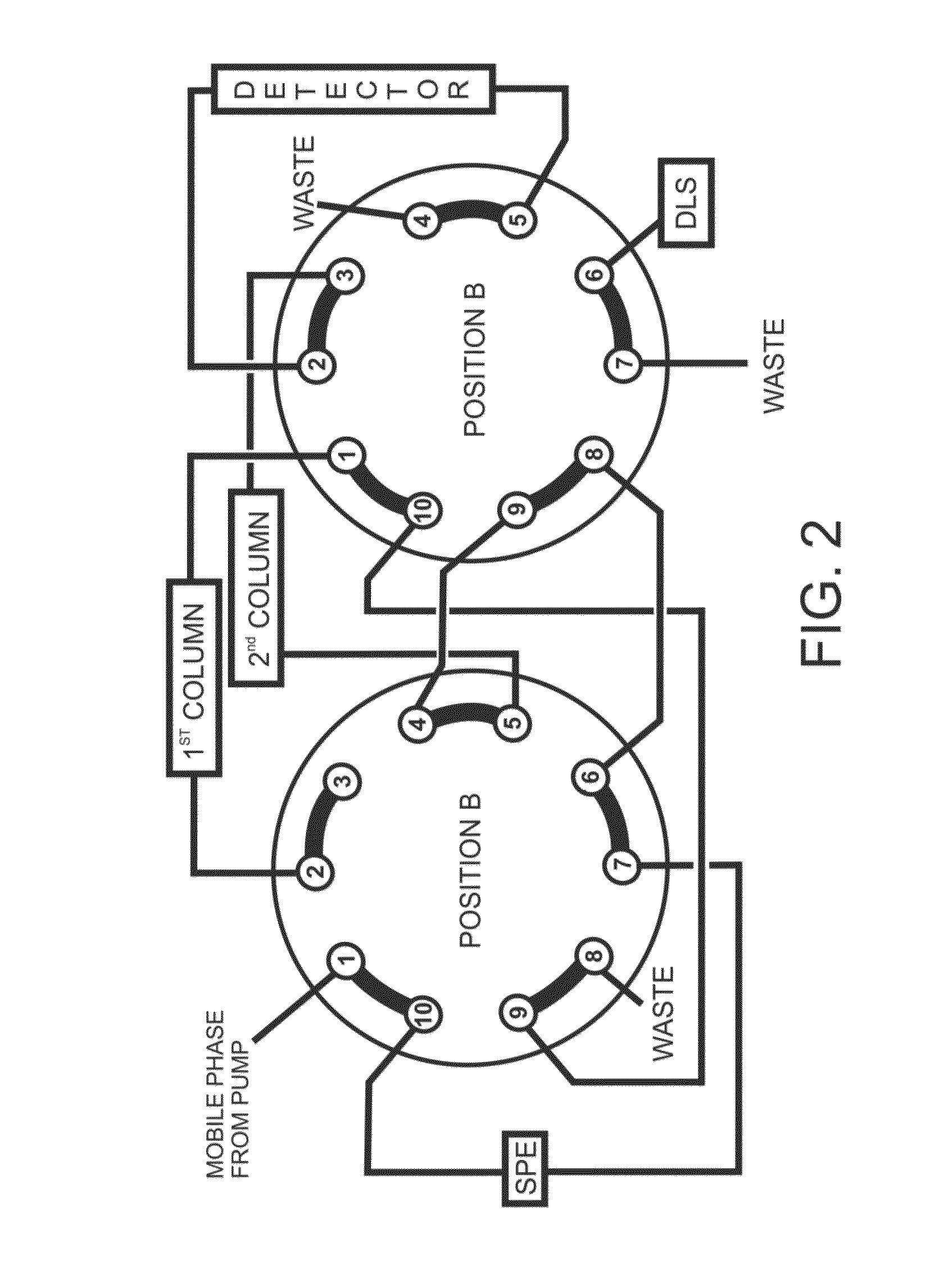Method and apparatus for characterizing impurity profile of organic materials
a technology of organic materials and impurities, applied in the direction of solid sorbent liquid separation, component separation, surface/boundary effect, etc., can solve the problems of inability to separate small molecules from each other, requires a lot of extra time, and is technically impossible to fully automate these systems
- Summary
- Abstract
- Description
- Claims
- Application Information
AI Technical Summary
Benefits of technology
Problems solved by technology
Method used
Image
Examples
example no 1
Two-Dimensional Separation and Determination of Poly-γ-Glutamic Acid (PGA), Caffeine, Thiourea and (±)-Propanolol Mix Solution
[0045]This example demonstrates the effectiveness of the two-dimensional liquid chromatography system. The analysis was performed on a HPLC system (Waters e2695 Separations Module) equipped with an Ultrahydrogel 500 column (Waters, 7.8×300 mm, 10 μm), an Oasis HLB online column (Waters, 4.6×20 mm, 5 μm), an XBridge BEH C18 column (Waters, 4.6×250 mm, 3.5 μm) and a UV / Vis detector (Waters 2489 UV / Vis detector). Briefly, 100 μL of the mix solution was injected to the mobile phase of the first dimension, which was made from high purity water (Millipore RiOs-DI 3, R≧18 MΩ) and contained 137 mM NaCl, 2.7 mM KCl, 10 mM Na2HPO4 and 2 mM KH2PO4. This buffer is also known as Phosphate Buffered Saline (PBS). The pH of the solution was set to pH=7.40. The mixture was chromatographically separated in the first dimension SEC column using isocratic elution. The flow rate w...
example no 2
Characterization and Determination of Impurity Profile of Drug-Loaded Nanoparticles (NPs)
[0047]This example demonstrates a two-dimensional liquid chromatography technique as applied for determining the impurity profile of a nanodrug. The characterization of nanoparticles was carried out with a HPLC system (Waters e2695 Separations Module) equipped with Ultrahydrogel 2000 column (Waters, 7.8×300 mm, 12 μm), an Oasis HLB online column (Waters, 4.6×20 mm, 5 μm), an XBridge BEH C18 column (Waters, 4.6×250 mm, 3.5 μm), a UV / Vis detector (Waters 2489 UV / Vis detector) and a DLS detector (Malvern Zetasizer Nano ZS). The two-dimensional liquid chromatography system comprising a first dimension size exclusion chromatography (SEC) subsystem and a second dimension HPLC subsystem adapted for reverse-phase compositional gradient elution chromatography. The connection between the first and the second dimension is provided by a SPE column. Briefly, 50 μL of the mix solution was injected to the mobi...
example no 3
Characterization of Monoclonal Antibody
[0050]This example demonstrates the efficiency of two-dimensional liquid chromatography system for the characterization of a monoclonal antibody (mAb). It was already presented in the two former examples that the system is not just functional, but highly efficient. Since the rituximab was purchased in a highly pure form, using of a two-dimensional system in these cases had become redundant. Therefore, in this example the first dimension was only used for characterizing the monoclonal antibody.
[0051]The experiment was carried out with a HPLC system (Waters e2695 Separations Module) equipped with an Ultrahydrogel Linear column (Waters, 7.8×300 mm, 10 μm), a UV / Vis detector (Waters 2489 UV / Vis detector) and a Dynamic Light Scattering (DLS) detector (Malvern Zetasizer Nano ZS). The flow rate was set to 0.80 mL / min using isocratic elution and both column and DLS detector were maintained at 30° C. Briefly, 20 μL of rituximab solution were in...
PUM
| Property | Measurement | Unit |
|---|---|---|
| mass | aaaaa | aaaaa |
| flow rate | aaaaa | aaaaa |
| flow rate | aaaaa | aaaaa |
Abstract
Description
Claims
Application Information
 Login to View More
Login to View More - R&D
- Intellectual Property
- Life Sciences
- Materials
- Tech Scout
- Unparalleled Data Quality
- Higher Quality Content
- 60% Fewer Hallucinations
Browse by: Latest US Patents, China's latest patents, Technical Efficacy Thesaurus, Application Domain, Technology Topic, Popular Technical Reports.
© 2025 PatSnap. All rights reserved.Legal|Privacy policy|Modern Slavery Act Transparency Statement|Sitemap|About US| Contact US: help@patsnap.com



